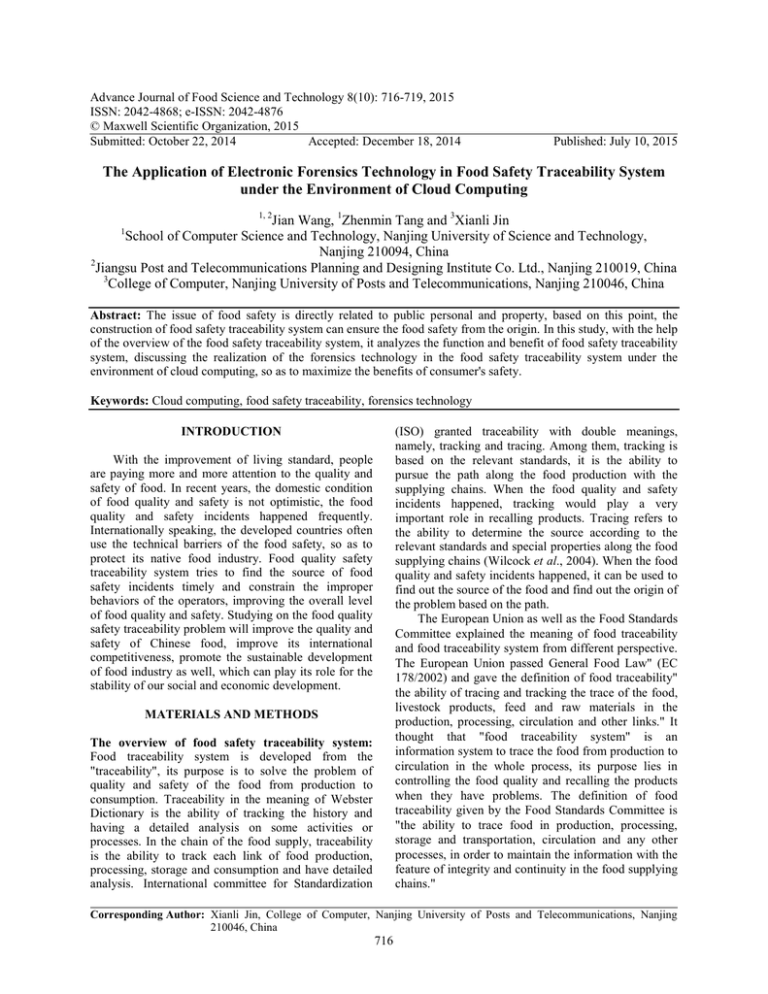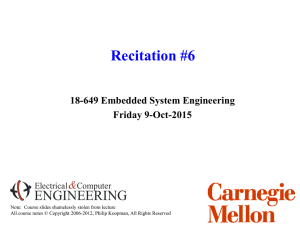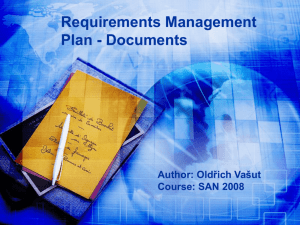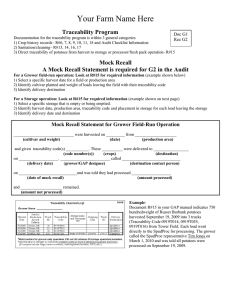Advance Journal of Food Science and Technology 8(10): 716-719, 2015
advertisement

Advance Journal of Food Science and Technology 8(10): 716-719, 2015 ISSN: 2042-4868; e-ISSN: 2042-4876 © Maxwell Scientific Organization, 2015 Submitted: October 22, 2014 Accepted: December 18, 2014 Published: July 10, 2015 The Application of Electronic Forensics Technology in Food Safety Traceability System under the Environment of Cloud Computing 1, 2 Jian Wang, 1Zhenmin Tang and 3Xianli Jin School of Computer Science and Technology, Nanjing University of Science and Technology, Nanjing 210094, China 2 Jiangsu Post and Telecommunications Planning and Designing Institute Co. Ltd., Nanjing 210019, China 3 College of Computer, Nanjing University of Posts and Telecommunications, Nanjing 210046, China 1 Abstract: The issue of food safety is directly related to public personal and property, based on this point, the construction of food safety traceability system can ensure the food safety from the origin. In this study, with the help of the overview of the food safety traceability system, it analyzes the function and benefit of food safety traceability system, discussing the realization of the forensics technology in the food safety traceability system under the environment of cloud computing, so as to maximize the benefits of consumer's safety. Keywords: Cloud computing, food safety traceability, forensics technology (ISO) granted traceability with double meanings, namely, tracking and tracing. Among them, tracking is based on the relevant standards, it is the ability to pursue the path along the food production with the supplying chains. When the food quality and safety incidents happened, tracking would play a very important role in recalling products. Tracing refers to the ability to determine the source according to the relevant standards and special properties along the food supplying chains (Wilcock et al., 2004). When the food quality and safety incidents happened, it can be used to find out the source of the food and find out the origin of the problem based on the path. The European Union as well as the Food Standards Committee explained the meaning of food traceability and food traceability system from different perspective. The European Union passed General Food Law" (EC 178/2002) and gave the definition of food traceability" the ability of tracing and tracking the trace of the food, livestock products, feed and raw materials in the production, processing, circulation and other links." It thought that "food traceability system" is an information system to trace the food from production to circulation in the whole process, its purpose lies in controlling the food quality and recalling the products when they have problems. The definition of food traceability given by the Food Standards Committee is "the ability to trace food in production, processing, storage and transportation, circulation and any other processes, in order to maintain the information with the feature of integrity and continuity in the food supplying chains." INTRODUCTION With the improvement of living standard, people are paying more and more attention to the quality and safety of food. In recent years, the domestic condition of food quality and safety is not optimistic, the food quality and safety incidents happened frequently. Internationally speaking, the developed countries often use the technical barriers of the food safety, so as to protect its native food industry. Food quality safety traceability system tries to find the source of food safety incidents timely and constrain the improper behaviors of the operators, improving the overall level of food quality and safety. Studying on the food quality safety traceability problem will improve the quality and safety of Chinese food, improve its international competitiveness, promote the sustainable development of food industry as well, which can play its role for the stability of our social and economic development. MATERIALS AND METHODS The overview of food safety traceability system: Food traceability system is developed from the "traceability", its purpose is to solve the problem of quality and safety of the food from production to consumption. Traceability in the meaning of Webster Dictionary is the ability of tracking the history and having a detailed analysis on some activities or processes. In the chain of the food supply, traceability is the ability to track each link of food production, processing, storage and consumption and have detailed analysis. International committee for Standardization Corresponding Author: Xianli Jin, College of Computer, Nanjing University of Posts and Telecommunications, Nanjing 210046, China 716 Adv. J. Food Sci. Technol., 8(10): 716-719, 2015 value, it can make up for the cost of the exporting country on this foundation, they are willing to adopt the traceability system. In our country, Quality Management and Quality Assurance-Terms (GB/T 6582-1994) defined traceability as: the ability to trace the history, the situation of application or the ability of considering the location. Traceability of the products can be included the origin of materials and parts, the processing history, the distribution and the place of the product after the delivery. Based on the above ideas, this study thinks, traceability system is a quality assurance system for recording and storing all relevant information in the supplying process of the products. Its purpose is to quickly and efficiently find out the reasons that caused problems and conduct the implementation of the recall, when the products have problems, so as to take targeted measures to punish them (Allen et al., 2008). Therefore, this paper defined food traceability system as: a system to trace food when it is into the market system, from production to circulation of each stages, so as to contribute to the quality control, which can recall the products when it is necessary. Improving the management level of agricultural products and food processing enterprises and the management level of food supplying and logistics chains: Food traceability contains one or some characteristics of food information throughout the products in the supplying chains. It is an effective means for enterprises to implement the competition strategy by controlling information. The establishment of traceability system is not only conducive to the management of business with its production flow and storage management, but also can control the unqualified raw material and production process, which also can be conducive to strengthening the communication between the enterprises, consumers and governments, so as to enhance the transparency and credibility of products. The realization of forensics technology in food safety traceability system under the cloud environment: The definition of forensics technology under the cloud computing environment: The definition of cloud computing: Cloud computing can be regarded as the combination and development of paralleled computing, distributed computing, grid computing technology as well as the other computer and network technologies. Simply speaking, cloud computing is through the network to spilt the huge calculation processing program into numerous smaller subroutines automatically, then it can form a huge system composed of many servers to search, analyze and calculate and pass the processing results back to the users. By using this technique, the network service provider can reach a deal within seconds, tens of millions or even billions of information can be dealt with, so as to have the same strong effectiveness of the network service as the super computer. The effects and benefits of traceability system of food safety: Traceability system is the most important function of the entire supply chain, as a communication tool and provide information tool. These information has a very wide range of uses. In the trace back system, the enterprise can through tracing back to the information to find the root of the problem and the cause and prevent problems and prevent its recurrence. Food traceability can provide true and reliable information to consumers, which can enhance the transparency of information and protect the consumer's right to know: Food traceability can play an important role in establishing market credit, it can be used as a tool to guarantee the authentic quality of food and provide reliable information for the consumers. Food traceability system can ensure the consumers the products through a specific standard operation, which can be used to guarantee the fairness of transaction and protect consumers from the fake products, so as to avoid damages and unfair competition among the producers and business operators. At present, there are many traceability systems used to support for tracing a specific brand label, declaration and certification to meet the specific demands of the consumers in the world, such as the traceability of organic food. The interpretation of electronic evidence: In 1991, at USA, the International Association of Computer at Specialists (IACIS) firstly proposed the concept of "computer forensics" (Bollen et al., 2007). Usually the computer forensics is also called electronic evidence, which refers that the staff can be in accordance with the legal norms to provide the related electronic evidence that can become legal, reliable, trustworthy information existed in the computer, during the process of the identification, acquisition, transmission, storage, analysis and presentation of the digital evidence. Enhancing the international competitiveness of food enterprises, protecting food trade: The internationalization of food system aims to protect their citizens with healthy food traceability system, which has important influence on the development of international food trade. If the traceability of food has become a standard for the accessing of market, moreover, the corresponding products can get higher The electronic forensics structure of new food safety traceability model based on cloud computing platform: This study puts forward the new model of computer forensics structure based on cloud computing 717 Adv. J. Food Sci. Technol., 8(10): 716-719, 2015 platform, namely "forensics cloud", the forensics cloud hierarchic structure is shown as Fig. 1, the bottom layer is the layer of hardware resource pool, which is mainly including CPU, the internal storage, memorizer, network equipments, bandwidth and other resources, it is the infrastructure layer for forensics cloud provided by hardware to provide support; the upper layer is virtualization software layer, its role is to use virtualization software such as VM-vare, XenServer, Hyper-V and other hardware resources with a plurality of logical virtual machines, namely, Virtual Machine (VM); then the upper layer is Virtual Machine (VM) layer, the role of which is as same as the real machine, the difference of it lies in the using method of resources; up the Virtual Machine (VM) layer is the Hadoop layer, which is a cloud computing platform layer, as well as the core of forensics cloud system, it can complete high-speed, real-time, reliable food safety traceability electronic forensics through the Map Reduce parallel programming model and HDFS distributed storage modules, cleaning and analyzing the redundant information and evidence and then provide evidence for people with clear evidence data; the last layer is the client terminal of electronic evidence, which can complete the main collection and display of the evidence information. Cloud computing platform itself has many advantages such as fast calculating speed, reliable feature of application and some other advantages, so the cloud computing technology (including virtualization technology, cloud computing platform of the distributed Hadoop) is adopted into the electronic forensic framework of food safety traceability system, which can solve the problems in the big data era of electronic evidence, such as low real-time slow speed and weak reliability, etc. Putting cloud computing technology into the electronic forensics framework of the food safety traceability system can bring the following benefits: • • It can use cloud computing platform to provide resources dynamically and flexibly, so as to meet the forensics demand maximally. It reduced the requirement on the forensic equipment used by the witness, as long as it had one installed browser and one terminal that can be accessed to the Internet, it had greatly reduced the cost of forensic. Fig. 1: The new electronic forensics structure based on cloud computing platform Fig. 2: Schematic diagram of the workflow of cloud forensic 718 Adv. J. Food Sci. Technol., 8(10): 716-719, 2015 • happened, it could track food flows according to the records in the process of all aspects from raw material to the last link of final consumption, recall the unconsumed foods with hazard and revoke its license, cut off from the origin, so as to eliminate hazards and reduce the loss. It can build a private forensic cloud above the public forensic cloud so as to ensure the confidentiality of the evidence, but when it is needed, private forensics cloud can be in remote assistance and remote collaboration. During the period of cloud forensics process, in order to make electronic evidence be better admissible in court, its effect of evidence and probative force must be guaranteed. Evidence should comply with the three standards of legitimacy, authenticity and relevance (Rrie et al., 2005). While the power of electronic evidence should meet the three criteria of reliability, integrality and sufficiency. Figure 2 shows the basic flow of cloud forensics. REFERENCES Allen, A., B. Golden, M. Taylor, D. Patterson, D. Henriksen and R. Skuce, 2008. Evaluation of retinal imaging technology for the biometric identification of bovine animals in Northern Ireland. Livest. Sci., 116: 42-52. Bollen, A.F., C.P. Riden and N.R. Cox, 2007. Agricultural supply system traceability, Part I: Role of packing procedures and effects of fruit mixing. BioSyst. Eng., 98(4): 391-400. Rrie, J.M.B., D.F. Broens, P. Folstar and G.J. Hofstede, 2005. Food safety and transparency in food chains and networks relationships and challenges. Food Control, 113: 481-486. Wilcock, A., M. Pun, J. Khanona and M. Aung, 2004. Consumer attitudes, knowledge and behaviour: A review of food safety issues. Trends Food Sci. Tech., 15: 56-66. CONCLUSION In order to maximize the protection for the consumer's safety, it has become the international consensus that the food chain should be traced from farm or ranch to table with the whole chain traceability principle by most countries and governments. Using the application of electronic forensics technology in food safety traceability under cloud computing environment, after the problems that do harm to people's health had 719




